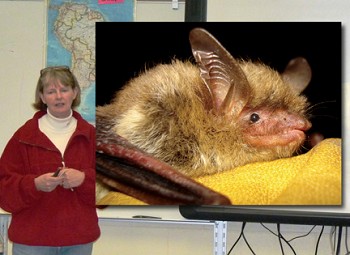SPRING VALLEY, WI - If the Department of Natural Resources (DNR) gets its way, Crystal Cave, a popular popular local tourist attraction, will be seriously impacted, and that has owners Jean and Blaze Cunningham very concerned.

Jean Cunningham, co-owner of Crystal Cave, tells a small crowd at the Spring Valley Middle High School the truth about bats and shares her concerns about a recent DNR ruling.
Photo by Kaye Bird
Inset: Little Brown Bat. Sun Argus file photo from DNR
|
And it's not just Crystal Cave; caves across the state and the country could find themselves having to make a difficult, if not impossible decision. Will these caves remain open to tourists or will they continue to be a home to bats? The DNR has determined either the tourists or the bats have to go.
The culprit behind all of this is an affliction known as White Nose Syndrome, a fungus that is killing bats. The name comes from the telltale white fungus growing on the noses of infected bats. Whole populations of bats in the eastern United States affected by this fungus are losing their fat reserves (which are needed to survive hibernation) long before the winter is over causing the bats to die of starvation. Since 2006, over a million bats have died.
WNS is spread through bat to bat transmission; this has been proven in the laboratory and th pattern in which WNS has spread between caves also appears to support this. Bats can migrate hundreds of miles, and some have inadvertently been transported via shipping containers and railcars.
The DNR believe that humans can spread the fungus possibly on clothes and equipment that aren't cleaned and decontaminated between visits to caves. The organization recommends excluding bats from all show caves, and this includes Crystal Cave.
Cunningham is disputing the DNR's research and its recommendation. "I have serious concerns about the science DNR is using. World renowned experts disagree with the DNR and what they are proposing," she said.
Another organization weighing in on the DNR's ruling is the U.S. Fish and Wildlife Service. The organization put out this statement. "Evidence is lacking to recommend the closure of commercial sites that offer cave tours to the general public. Visitors to commercial sites are less likely to visit multiple caves in a short time-period, generally wear plain clothes and shoes that are not repeatedly used for cave-related activities, and are considered to pose a very low risk for the spread of WNS to new caves."
According to Cunningham, to date there has been no proof of humans contaminating caves. "The Wisconsin DNR is ignoring both the research and the science," she said. And that's not the only thing upsetting Cunningham. It's the way the DNR has conducted itself.
"I didn't know anything about this emergency ruling from the DNR until September 20 when I got an email from the general manager of Cave of the Mounds near Madison. He had received a phone call from an Associated Press reporter asking for a comment," said Cunningham.
An emergency meeting was to be held the next day, September 21 in Madison. Neither Cunningham nor the manager from Cave of the Mounds would be allowed to speak because they had missed the deadline for making that request-a deadline and they didn't even know about. "The materials came out after the deadline," she said adding, "There has been a real lack of communication from the DNR."
The Emergency Rules adopted on September 22 give the DNR the authority to manage and develop rules to protect the bats, and allows them to try and prevent the fungus from coming into the state and/or spreading. That means that if the Cunninghams want to continue to operate Crystal Cave as a show cave, the DNR has the authority to remove the bats.
"Wisconsin is the only state that plans to close show caves if owners don't comply with the DNR ruling," said Jean. If caves are closed, the bats will be fine but the show cave will be out of business. If show caves remain open, the bats will be removed.
"The Natural Resources Board had agreed to accept the DNR recommendations. What happens in Wisconsin could impact the entire country," said Cunningham.
But there is hope. "We went to Madison to address our concerns on October 27; we were able to get an amendment after that meeting. This amendment gives us 45 days to work with the DNR to try and modify their management plan," she said.
In the meantime, public input is encouraged. First of all, Jean recommends that the public becomes familiar with WNS by visiting www.batcon.org. Secondly, for more information on the Wisconsin DNR rulings and its management plan, log on to:
http://dnr.wi.gov/org/nrboard/2010/September/09-10-3B12.pdf.
"If people disagree with the DNR," said Cunningham, "it is critical that they let the DNR know it's going in the wrong direction. They can do this by writing letters to Stacy Rowe, DNR Bureau of Endangered Resources, P.O. Box 7621, Madison, Wisconsin 53707. Stacy can also be reached via email at stacy.rowe@wisconsin.gov.
The public will also have an opportunity to attend a meeting regarding the DNR's ruling on November 29 beginning at 11:00 a.m. This meeting will be held at the Division of State Facilities, Eau Claire State Office Building, Room 139, 718 West Clairemont, Eau Claire, Wisconsin.
"Our biggest concern is to save the bats," said Cunningham. "There is no proof that humans can carry this fungus from cave to cave. We are asking DNR to reconsider."
Next week: Why we should care about bats and Crystal Cave

